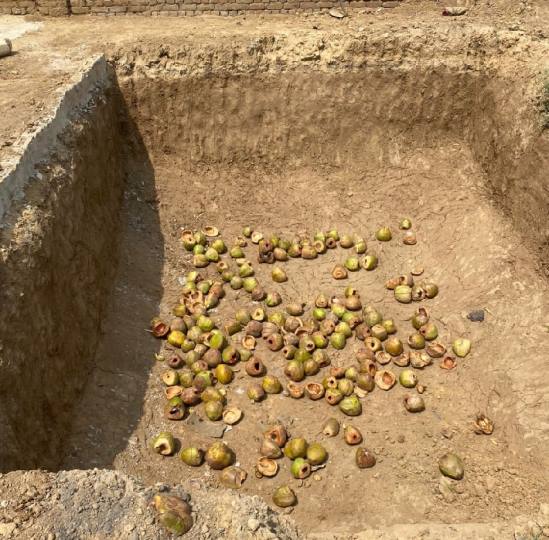
A groundbreaking natural Sewage Water Treatment Plant (STP) has been recently established at the Save Aravali Nursery, located at Sainik Colony, Faridabad. This innovative STP has emerged as an exceptionally cost-effective solution for treating sewage water, which is then harnessed to nourish a lush landscape comprising over a staggering 100,000 trees thriving in the Aravali range.

This eco-friendly STP employs an array of entirely natural methods, eschewing the use of synthetic materials. Instead, a harmonious synergy of elements such as charcoal, stones, coconut shells, human hair, and wood dust has been ingeniously harnessed to meticulously filter the water. These elements not only cleanse the water but also ensure the equilibrium of critical factors like Biological Oxygen Demand (BOD) and Chemical Oxygen Demand (COD) levels, which are pivotal indicators of water quality.

The driving force behind the success of this remarkable endeavor are the dedicated visionaries, Jagmohan Yadav and Raju Rawat, stalwarts of the environment team. Their unwavering commitment, coupled with the unwavering support of enthusiastic volunteers from Oracle and the Save Aravali community, has been instrumental in bringing this visionary STP to fruition. By transforming sewage water into a valuable resource that breathes life into the Aravali landscape, this initiative stands as a testament to the potential of nature-inspired solutions and collective action. The STP's role in sustaining the delicate balance of the ecosystem while offering a sustainable water source for the thriving green cover serves as a beacon of inspiration for environmentally-conscious endeavors far and wide.

The process is a combination of natural and engineered processes that work together to treat sewage and purify water. This is often referred to as a decentralized or natural wastewater treatment system. Here's a detailed explanation of each step:
-
Passing Through Various Sizes of Rocks:
-
In this step, sewage water is allowed to flow through a bed of various sizes of rocks or gravel. This helps in the initial settling of solid particles present in the sewage water. Larger solids settle down due to gravity, while smaller suspended particles might continue to move with the water.
-
Turbulence caused by the flow of water through the rocks promotes oxygenation. Oxygen dissolves into the water, which is crucial for the survival of aerobic bacteria that play a significant role in breaking down organic matter in subsequent stages.
-
The surfaces of rocks provide attachment sites for beneficial microbes. These microbes aid in the biological breakdown of organic materials present in the sewage.
-
-
Multiple Charcoal Zones:
-
Charcoal has a large surface area with many microscopic pores. This feature makes charcoal highly effective for adsorption and the attachment of microbes.
-
In this step, the sewage water passes through multiple layers of charcoal. The charcoal adsorbs impurities, organic compounds, and even certain chemicals present in the water.
-
The high microbial activity that develops on the charcoal surfaces further aids in the filtration and degradation of pollutants. Beneficial bacteria living on the charcoal help to break down complex organic compounds into simpler substances.
-
-
Coir (Coconut Fibre), Human Hair, Wooden Shavings:
-
Coir, human hair, and wooden shavings are natural materials that have a fibrous texture. These materials are used to filter out oil, grease, and other substances that might be present in the sewage.
-
The fibrous nature of these materials traps and absorbs oil and grease, helping to remove them from the water.
-
Additionally, the presence of these materials can contribute to reducing the biological oxygen demand (BOD) of the water. BOD is a measure of the amount of oxygen required by microorganisms to break down organic matter. Lower BOD indicates cleaner water.
-
-
Roots of Water-Purifying Plants:
-
Certain aquatic plants, known as water-purifying plants, have the ability to absorb and accumulate heavy metals and toxins present in the water through their roots.
-
As sewage water passes through the root systems of these plants, the plants absorb pollutants, which can include heavy metals like lead, mercury, and cadmium.
-
-
Earthworm Bed:
-
Earthworms play a role in breaking down organic matter and promoting nutrient cycling in the soil. Similarly, in this context, an earthworm bed helps in further purification of the water.
-
The presence of earthworms aids in reducing ammonia levels in the water and helps maintain a neutral pH.
-
In summary, the process is a combination of physical, chemical, and biological processes that work together to treat sewage water and purify it. Each step targets specific types of pollutants and utilizes natural processes and materials to achieve effective treatment. It's worth noting that the effectiveness of such a system can depend on factors such as the design of the treatment plant, the types of pollutants present in the sewage, and the specific types of plants and materials used.

This project would not have been possible without the support of Oracle which resonates with our aim of establishing sustainable sources of water. In the words of an Oracle employee, “Only when we replace complains with action, will we be able to work towards a better planet”










